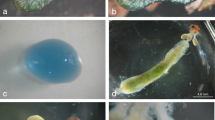Abstract
The iridoid glycoside antirrinoside was found to be sequestered by highly aposematic larvae of the geometrid mothMeris paradoxa and two noctuid mothLepipolys species feeding onMaurandya antirrhiniflora (Scrophulariaceae), a natural food plant from southern Arizona. The antirrinoside content of leaves and petioles being consumed, eariy-instar larvae, late-instar larvae, larval frass, regurgitant, reflex-bleeding emission (Meris paradoxa), cocoons, pupae, meconium emitted upon eclosion, and adult moths was determined. Larvae, other than the earliest instars, did not excrete antirrinoside in the frass, but sequestered it in amounts of 3–11 % of the dry weight. Small amounts of antirrinoside remained in various pupal or cocoon parts and some was emitted in the meconium upon eclosion. The total antirrinoside accounted for was, however, considerably below that expected based upon the remarkably high 20% content of the leaves and petioles being consumed. The adult cryptic moths of both species contained little or no antirrinoside. This is the first report of a natural food plant and larval stages forM. paradoxa and a previously undescribedLepipolys species. It is also the first report of antirrinoside sequestration and utilization by insects.
Similar content being viewed by others
References
Bowers, M.D. 1988. Chemistry and coevolution: Iridoid glycosides, plants, and herbivorous insects, pp. 133–166,in K. C. Spencer, (ed.). Chemical Mediation of Coevolution, Academic Press, San Diego.
Bowers, M.D., andPuttick, G.M. 1986. The fate of ingested plant allelochemicals: Iridoid glycosides and lepidopteran herbivores.J. Chem. Ecol. 12:169–178.
Comstock, J.A. 1958. The early stages ofOncocnemis perscripta (Guenee).Bull. So. Calif. Acad. Sci. 57:81–84.
Dyar, H.G. 1903. New North American Lepidoptera with notes on larvae.Proc. Entomol. Soc. Washington 5:290–298.
Franke, A., Rimpler, H., andSchneider, D. 1987. Iridoid glycosides in the butterflyEuphydryas cynthia (Lepidoptera, Nymphalidae).Phytochemistry 26:103–106.
Gardner, D.R., andStermitz, F.R. 1988. Host-plant utilization and iridoid glycoside sequestration byEuphydryas anicia (Lepidoptera: Nymphalidae).J. Chem. Ecol. 14:2147–2168.
L'Empereur, K.M., andStermitz, F.R. 1990a. Iridoid glycoside content ofEuphydryas anicia (Lepidoptera: Nymphalidae) and its major hostplant,Besseya plantaginea (Scrophulariaceae), at a high plains Colorado site.J. Nat. Prod. 16:187–197.
L'Empereur, K.M., andStermitz, F.R. 1990b. Iridoid glycoside metabolism and sequestration byPoladryas minuta (Lepidoptera: Nymphalidae) feeding onPenstemon virgatus (Scrophulariaceae).J. Chem. Ecol. 16:1495–1506.
Rindqe, F.H. 1981. A revision of the moth generaMeris andNemeris (Lepidoptera, Geometridae).Am. Mus. Novit. No. 2710.
Stermitz, F.R., Gardner, D.R., Odendaal, F.J., andEhrlich, P.R. 1986.Euphydryas anicia (Lepidoptera: Nymphalidae) utilization of iridoid glycosides fromCastilleja andBesseya (Scrophulariaceae) hostplants.J. Chem. Ecol. 12:1459–1468.
Stermitz, F.R., Gardner, D.R., andMcFarland, N. 1988. Iridoid glycoside sequestration by two aposematicPenstemon-feeding geometrid larvae.J. Chem. Ecol. 14:435–441.
Sutton, D.A. 1988. A Revision of the Tribe Antirrhineae. British Museum and Oxford University Press, London.
Author information
Authors and Affiliations
Additional information
Chemistry of the Scrophulariaceae. 20. Paper 19: Stermitz, F.R., Ianiro, T.T., Robinson, R.D., and Gardner, D.R. 1991.J. Nat. Prod. 54:626–628.
Rights and permissions
About this article
Cite this article
Boros, C.A., Stermitz, F.R. & McFarland, N. Processing of iridoid glycoside antirrinoside fromMaurandya antirrhiniflora (Scrophulariaceae) byMeris paradoxa (Geometridae) andLepipolys species (Noctuidae). J Chem Ecol 17, 1123–1133 (1991). https://doi.org/10.1007/BF01402938
Received:
Accepted:
Issue Date:
DOI: https://doi.org/10.1007/BF01402938




